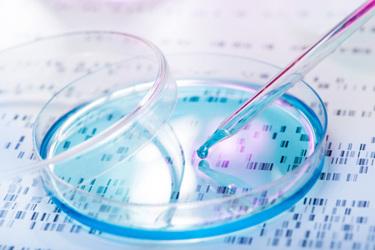Do We Really Understand Plasmid Quality's Effects On mRNA Production?
By Antony Hitchcock, principal and owner, AGH Bioconsulting, and Philip Probert, Biologics Technology Lead, CPI

Plasmid DNA first emerged as a potential therapeutic agent and vaccine system in the 1990s, including for potential HIV and TB vaccines. However, the lack of success of these products as a gene delivery vehicle led clinical developers to switch to viral vectors, initially using adenovirus but then switching to adeno-associated virus (AAV) and lentiviral vector.
The preferred production route for these vectors has been through the use of transient expression approaches where the structural genes and replication functions of vector genes are carried on two or three plasmids and the functional gene is carried on an additional plasmid. This use of plasmid as a template rather than a drug product has been extended to its use in cell-free manufacturing processes, especially for mRNA and synthetic DNA such as the Doggybone from Touchlight Genetics, for a number of years. However, the success of the mRNA COVID-19 vaccines has led to a significant increase in interest and investment in cell-free production beyond mRNA vaccines and therapies.
Despite the very different applications, the process and product specification for template plasmid DNA is the same whether it will be used for viral vector, mRNA, or synthetic DNA manufacture.
In this article we will look at the origin of the current guidelines and specifications and ask questions around the level of knowledge behind these specifications and the need for greater understanding of the potential effects of plasmid quality on vector and mRNA production.
Origin And Background Of Plasmid Regulation
Plasmid vaccines
The earliest regulations focused on plasmid DNA and the required specifications and quality systems were issued by the FDA in 2007. They were focused on plasmid DNA vaccines and included suggested product specification as shown in Table 1 below.
Table 1
| Specification | |
|---|---|
| Plasmid Supercoiling | >80% |
| cDNA | <1% |
| RNA | <1% |
| Host Protein | <1% |
| Endotoxin | <40Eu/mg |
Plasmid templates
In recent years, there has been debate regarding the quality systems applied to plasmid DNA used as a template product, specifically regarding the use of “high-quality” plasmid in place of GMP-grade plasmid for early-phase clinical production to reduce costs and timeline for product developers. On the other hand, there has been little discussion around product specifications.
The most recent guidelines from the EMA and USP give guidance on quality systems to be applied for clinical phases but give no information on product specifications
However, in June 2022, BioPhorum provided a guidance document for producers using plasmid DNA as a starting material.
These guidelines include suggested specifications, which include potential loosening of the limits for host contaminants, with the proviso that specifications should be set according to the end-user requirements as shown in Table 2 below.
Table 2
| FDA | BioPhorum | |
|---|---|---|
| Plasmid Supercoiling | >80% | 80–85% |
| cDNA | <1% | 1–5% |
| RNA | <1% | 1–5% |
| Host Protein | <1% | 1–2% |
| Endotoxin | <40Eu/mg | 20–100Eu/mg |
Plasmid impurities and analytics
Looking more closely at plasmid impurities, these can be split into product- and host-related impurities. The key host-related impurities are RNA, chromosomal DNA, host protein, and endotoxins. These assays are performed using standard ELISA and qPCR-based assays and, in some cases, ddPCR.
Product-related impurities relate to the plasmid forms, specifically supercoiling. The level of supercoiling tends to be an indicator of plasmid stability throughout the process. It is affected by plasmid sequences and process operations especially around lysis. Plasmid purity is also assessed to look at additional plasmid forms, often through electrophoretic techniques such as agarose gel electrophoresis or capillary electrophoresis; however, limited, if any, specifications are set around this, but it is reported as a percentage of total plasmid DNA.
Plasmid identity and sequence integrity
Arguably, identity and sequence integrity are the most important measures of plasmid quality.
- Firstly, we must determine that the plasmid identity is correct and that they are not contaminated with other plasmids.
- Secondly, we must confirm sequence integrity to ensure there have been no deletions or rearrangements from the intended sequence.
Sequencing is performed during the selection and laying down of cell banks as well as for bulk and final plasmid products. Historically, this has been done through Sanger sequencing, where the requirement is for the plasmid to meet the intended sequence in compliance with the reference plasmid. While it is possible to perform sequencing using next generation sequencing (NGS), this is usually only used to confirm sequence on cell banks and for information on plasmid products including the sequencing of inverted terminal repeat (ITR) regions, but it is not currently used as a GMP release assay.
NGS provides a significantly more sensitive approach, but it potentially raises challenges in terms of product purity release testing when identifying low levels of sequence heterogeneity that are not identified using Sanger sequencing, such that product may be deemed non-compliant with the reference material.
This is an area that should be considered as part of future regulatory guidance — to enable a move toward specification based on a percentage of identity alignment to the reference since entirely-homogenous sequence identity is unlikely to be attainable now or in the longer term. NGS, particularly third-generation-based approaches, potentially can analyze more than base identity. They can also analyze modifications, including those of particular relevance to mRNA, including mRNA capping and modified base incorporation. As such, the ability to utilize NGS within product release would be an advantage while also giving a more accurate picture of product quality.
Effect of plasmid impurities on vector production
The logic behind selection of specific values for acceptable impurity levels is not totally clear and is essentially a risk-based approach used by end users. A key measure of plasmid quality is the level of supercoiling. While there is a belief that increased supercoiling levels improve process outcomes with relation to vector production, very little published data supports this hypothesis. The same applies to the levels of host contaminants. There is a general acceptance that these will be cleared from the product post-transfection/transcription with limited, if any, studies into the effects of these contaminants on vector productivity or purity.
Effect on cell-free processes
Cell-free processes are based on the enzymic amplification of plasmids or entirely-synthetic sequences to generate both mRNA and DNA products. The processes are clearly and significantly simpler than vector production processes but lack any biological quality control systems intrinsic to cellular processes. As such, they may be more sensitive to changes in the purity/nature of the plasmid template. So, a key question is: Are there critical quality attributes (CQAs) for plasmid for cell-free production, both in terms of host contaminants and in connection to plasmid-related impurities?
At present, while there are indications that template DNA purity may impact the yield and quality outcomes from cell-free processes, there remains a gap in published knowledge as to the specific effects, despite the effects on resulting product quality being understood.
For example, the fidelity of cell-free DNA is recognized to be generally less than that of E. coli-derived plasmid DNA. This is despite enzymes such as Phi29 having proofreading activity and examples of high fidelity being achieved. mRNA potency can also vary in response to starting with DNA templates from different sources but with comparable specifications.
RNA polymerase fidelity is variable with an error rate higher than that of DNA polymerases used in synthetic template generation, which is a confounding and often-ignored factor when assessing the effects of DNA template on product quality.
Host contaminants are unlikely to be major variability drivers in product quality. Instead, the key question is the degree to which integrity and identity of template DNA influence the associated integrity and identity of a cell-free/enzymatically generated DNA or mRNA. This question goes beyond the volume of truncated DNA forms and includes damaged/nicked DNA. More routine application of NGS, and the associated fuller picture of DNA quality, will support such understanding.
Unfortunately, the definition of specific CQAs for plasmid DNA as a template for cell-free synthesis has not been prioritized or progressed, with plasmid DNA suppliers relying on the same specifications as for vector production despite anecdotal evidence highlighting variability of performance of plasmid DNA from different suppliers in cell-free applications.
Effects of sequence differences
For cell-free processes, it is known that generation of product impurities can be related to template sequence. The ability to define the absolute impact of sequence separate from other confounding variables such as process, starting plasmid quality, and purification remains a limitation in connecting sequence to product quality. Cell-free DNA generation appears less susceptible to errors introduced from repetitive DNA or long homopolymer sequences, such as those required for vector or mRNA products that challenge E. coli-based amplification. It is likely that for enzymes used for cell-free DNA generation such as Phi29, sequence and associated secondary structures will contribute to some product variability, but limited data currently exists to definitively understand the impact.
For mRNA generation through in-vitro transcription, significant data links the generation of double-stranded RNA (dsRNA) to specific sequence elements when using T7 polymerase. To what extent sequence may also affect other quality parameters is less clear owing to the aforementioned confounding factors.
Synthetic Vs. Cell-Derived Template DNA For mRNA Generation
There remains reticence to use synthetic DNA for mRNA generation given the acceptance plasmid DNA has gained over several decades of use. Aforementioned concerns over fidelity of synthetic DNA remain a perceived risk based on the significant fidelity attainable from plasmid. However, within a manufacturing context, fidelity appears sufficient, with synthetic DNA also bringing reduced risk of recombination and variability between sequences, with freedom from origins of replication and resistance markers.
Insofar as the manufacturing process is consistent, then synthetic DNA can perform comparably to plasmid DNA. Inconsistencies encountered between identical templates produced cell-free vs. cell-based can frequently be attributed to quality of starting template or process differences, including linearization.
Linearization, and associated purification of DNA templates are required before use in in vitro transcription. This series of steps introduces variability, consistent between template formats but generally given little attention in terms of potential impact of DNA quality and, by extension, mRNA quality.
More broadly, gaps in understanding of DNA quality remain a limitation in forming a complete understanding of the relative performance of different DNA template formats. Crucially, for personalized therapies, synthetic DNA is the only practical approach available based on necessary timelines and cost and, therefore, further uptake is expected as such immunotherapies reach the market.
Next Steps: Plasmid Markets
Currently, the largest market for plasmid DNA is the viral vector market, where it makes up a significant part of the overall demand, and vector producers are continually looking at routes to reduce costs and timelines, especially where material is being supplied for first-in-human studies. To achieve this, plasmid producers apply platform processes where there is little, if any, process optimization for individual plasmids. There are limited incentives to improve plasmid quality for the viral vector market.
The mRNA market is smaller, with a limited amount of material needed for clinical trials and an immature commercial market outside of COVID vaccines. So, incentives to invest in process improvement will be limited unless end users are prepared to pay increased costs for plasmid products. With evidence suggesting mRNA’s quality is particularly sensitive to quality of DNA inputs, process improvement may be crucial. Product quality’s reliance on DNA template quality means that many companies will increasingly experiment with synthetic DNA templates and explore manufacturing in-house as a means of controlling what is a critical raw material.
About The Authors:
 Tony Hitchcock is the principal and owner of AGH Bioconsulting. He has spent his decades-long career in the in the biotechnology field, with over 30 years in the production of complex biologic for clinical trials in the European Union and U.S. He has worked in areas of process development and manufacturing with experience in engineering and process systems. He has worked on the development of more than 30 products for clinical trials including plasmid DNA, viral and bacteriophage products, and recombinant proteins from microbial, mammalian, and insect cell sources. Contact him at tony@aghbioconsulting.com.
Tony Hitchcock is the principal and owner of AGH Bioconsulting. He has spent his decades-long career in the in the biotechnology field, with over 30 years in the production of complex biologic for clinical trials in the European Union and U.S. He has worked in areas of process development and manufacturing with experience in engineering and process systems. He has worked on the development of more than 30 products for clinical trials including plasmid DNA, viral and bacteriophage products, and recombinant proteins from microbial, mammalian, and insect cell sources. Contact him at tony@aghbioconsulting.com.
 Philip Probert is biologics technology lead at CPI. With over 10 years’ experience in the design and execution of a diverse portfolio of innovation projects focused on the development and scale-up of biologic therapeutics and vaccines. His expertise covers the breadth of biologic modalities, with particular subject expertise in synthetic and cell-free manufacturing processes for nucleic acids and proteins. Contact him at philip.probert@uk-cpi.com.
Philip Probert is biologics technology lead at CPI. With over 10 years’ experience in the design and execution of a diverse portfolio of innovation projects focused on the development and scale-up of biologic therapeutics and vaccines. His expertise covers the breadth of biologic modalities, with particular subject expertise in synthetic and cell-free manufacturing processes for nucleic acids and proteins. Contact him at philip.probert@uk-cpi.com.
